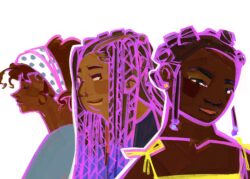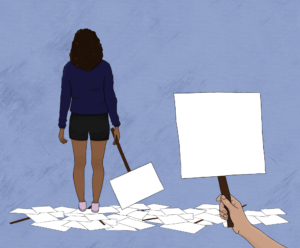Bobby Nishimwe (COL ’22) is ready to get back on the dance floor.
He’ll get the opportunity soon: Georgetown’s Black Student Alliance (BSA) is hosting its first in-person Visions of Excellence Ball since the pandemic began, heading to the Mayflower Hotel on May 1 for a night of celebration. This year’s masquerade marks the 25th anniversary of BSA’s hallmark event, a milestone that testifies to the resilience of Georgetown’s Black community and its reach towards restoring the joys of pre-pandemic life.
“At some point 25 years ago, there was a group of Black students who believed that there needed to be some sort of event to celebrate each other,” Nishimwe, who attended the 2019 Ball and will attend its 2022 iteration, said. “The fact that 25 years later, it’s still going on, it’s still taking place, it also showcases how much this is a staple event in the Black community here at Georgetown and how important it is to us.”
Visions is more than just a dance party; it’s the only gala-type event all year that explicitly celebrates Black students and other Hoyas who have contributed in extraordinary ways to the on-campus Black community. It brings much of Black Georgetown and its non-Black allies under one roof to finally pay tribute to meaningful work often unrecognized by the rest of the university.
At each year’s Visions, its Planning Committee—chosen via an application to BSA—confers awards to winning male and female nominees in roughly 14 categories, spanning Athletic Achievement to Fine Arts to Community Service. Black seniors and other seniors of color are mostly honored, but the committee also gives awards to exemplary faculty, alumni, and underclassmen. Nominations are democratically sourced from the broader community, giving the trophies a collective legitimacy.
“Visions is different [from other galas] because it specifically encapsulates leaders and impacts done by and for the Black community, which sometimes isn’t really recognized by the university as a whole,” Lauren Smith (COL ’18, LAW ’24), BSA President from 2017-2018 and 2018 Campus Leadership Award winner, said.
Urban legends trace Visions’ origin story to a group of Black Hoyas disgruntled by informally segregationist attitudes threaded into the social norms of Georgetown’s other formal parties. The SFS’ Diplomatic Ball, advertised as a black-tie event to convene Georgetown students, alumni, and foreign dignitaries, has long been an elitist campus symbol, attendance indicative of wealth and status. Whether that environment has been equally accessible to students of color is questionable: The first “Dip Ball” was in 1925, 30 years before Georgetown admitted its first Black undergraduate student.
Clubs’ private galas, of varying levels of accessibility, are rarely planned by and for Black students and students of color. Visions thus stands in stark contrast to a gala culture where even basic norms—like having city police officers serve as event security in spite of long-standing anti-Blackness in law enforcement—can make marginalized students feel unwelcome.
“[Visions] is an act of saying that for whatever reason we don’t feel welcome or fully appreciated or able to fully be ourselves in other spaces, so we’re just going to create our own,” Smith said.
Often Visions becomes a ceremony of “giving flowers”—as Jazmin Pruitt (COL ’19), BSA President in 2018-2019 and the 2019 Campus Impact Award winner, put it—to those who traditionally fly under the radar. “Visions is a reminder to Black students as well as students of color that they matter, which I don’t think is often something promoted or said aloud,” she said, pointing out that labor done by Black students rarely gets rewarded, monetarily or otherwise. Be it mentoring peers, leading activist work, or organizing events, Black Hoyas are often bettering each other and the larger Georgetown community. According to Pruitt, Visions is a way to finally honor those (often voluntary) efforts.
Smith noted the realities of uncompensated and unrecognized Black student labor at Georgetown. “Between all the diversity committees and the protests, and these other things that by nature the university is not going to recognize, because it would be them acknowledging using our uncompensated labor,” she said. “They’re kind of silent in that regard, but at something like Visions, we can do that. We see the things that don’t get university recognition but that’s valuable, important work.”
Indeed, Visions honors those who serve in deeply meaningful capacities without running the gamut of formal leadership titles. It also recognizes those who lead quietly. Smith cited the Campus Ministry award, which honors a student others feel spiritually inspired by and comfortable to turn to, as a particularly good example: “That’s someone who might have slipped through the cracks in other decision-making processes.”
Minnie Quartey Annan (COL ’05, M.A. ’06, PhD ’22) received the Community Service award in 2005. As an RA, she turned a compassionate potluck Thanksgiving dinner for one of her Harbin residents who couldn’t go home into a yearly community tradition and a catering group, and she still remembers it clear as day.
“I just remember that moment being so amazing and feeling so honored because you know my peers had really seen me cooking this meal and giving food as not just like, hey come eat, but as a labor of love and a way to build community,” Quartey Annan said, recalling the gala. “When I think about Visions, I think about that. I think about a sense of community.”
Cultivating community at Visions often transcends the subgroups of Black Georgetown, Nile Blass (COL ’22), current BSA President and Visions Planning Committee member, said. Structural barriers like schedules that might stop, say, Black football players from being able to attend BSA general body meetings, vanish for the ball, Blass noted. Niches merge.
“Visions is very unique in that there are a lot of Black communities—because there are lots of subcommunities within Blackness—and Black people that are meeting and interacting in these spaces that aren’t typically,” she said. “The way I see a lot of Black people at Georgetown engaging with Visions is separate from the standard separations.”
Building relationships across years and subcommunities is a rallying point of Visions, where seniors are predominantly honored but underclassmen are welcome. That’s especially true during COVID-19, where opportunities to build cross-year relationships have been dampened. “There’s sort of a generational gap there,” Nishimwe said. “I believe Visions is at least going to help, give us an opportunity to convene together and for the different classes to be able to reconnect, get to know each other.”
To Blass, the intergenerational audience is important to cultivate political consciousness, too. Each year, Visions is themed: Mask Off for 2018, Our Ancestors’ Wildest Dreams for 2019, and the 2022 ball centers W.E.B. Du Bois’ concept of “double consciousness.” A term crafted in Du Bois’ The Souls of Black Folk, double consciousness refers to Black Americans’ experience of having their identity split into two—Black and American—by racist structures and attitudes. At Georgetown, many students of color often find their racial and Hoya identities forced to be at odds with one another—where to fit in as a Hoya, race must be muted.
“It can be conflicting to be a Hoya and to be marginalized. And there are oftentimes environments where it is requested of you—whether explicitly or implicitly—to separate those identities and to operate in a different framework,” Blass said, criticizing an environment that sets Blackness at odds with what is professional, appropriate, or acceptable.
A Tanzanian immigrant who moved to Iowa when he was eight, Nishimwe also found the theme especially resonant. “The theme of double consciousness is very true of what my entire experience in this country has been, and even to some extent, at Georgetown,” he said.
“On campus, I feel like I have certain spaces, right, where I’m just me and I don’t really care what anybody thinks. And there are other spaces where—I don’t want to say I put on a layer—but I have to be a little more reserved in terms of how much of myself I reveal or showcase.”
The masquerade format of this year’s Visions helps reframe double consciousness as dynamic, not immutable. It’s a frame shift useful for both underclassmen learning to navigate the predominantly white Georgetown as well as seniors moving onto professional or graduate environments that might invoke new forms of dual identity, according to Blass.
“You can take [masquerade] masks off,” Blass said. “Even if that is the socialization standard of Georgetown, it’s not a permanent frame of existence, nor should it be one that we have to take onto other spaces. This is what it is, but you have the ability to merge consciousnesses—you can do both.”
Theme aside, Dajourn Anuku (COL ’22)—who co-hosted Visions in 2019, performed during its online virtual iteration in 2021, and now is gearing up to attend in 2022—saw the ceremony through the lens of care ethics.
“[Visions] was eye-opening to the aspect of just us having fun and taking up space in such a moment with all of us looking good. And all of us just dancing and singing, telling jokes and storytelling—all of that itself is a form of resistance,” he said, referring to writer Audre Lorde’s conception of self care as resistive. “Imagine a ball being a form of resistance.”
This is not to say Visions simply glorifies making Blackness a site of resilience; it’s also a testament to the ability of Black leaders on campus to always create safe, joyous spaces in the face of difficulty. “There is always going to be a way in which we find community with one another,” Anuku said, reflecting on the return of in-person Visions in a pandemic-addled world. “It’s also really fun to just see how we can exist out of all the madness and chaos of trying to survive at Georgetown.”
When it comes to putting Visions together, funding is precarious, with the ball’s price tag running in the tens of thousands for venue, security, catering, and more. Yearlong planning is requisite, and this year’s committee, according to Blass, began its preparations in October, pursuing grants, donors, and corporate sponsors.
Support for Visions from the rest of the campus community has been historically complicated. In 2014, the Corp’s philanthropy arm denied Visions funding for the third year in a row on the grounds that it did not represent the Corp’s mission of “students serving students.” Though The Hoya reported an informal boycott occurred, the 2013-2014 BSA Executive Board put out a statement dispelling rumors it had endorsed any sort of collective action against a fellow student-run organization. Still, debate ensued regarding what “serving students” really meant—questioning whether mainline institutions like the Corp were adequately supporting marginalized communities on campus. (In 2022, the Corp did provide the requested sum of money to Visions, Blass mentioned.)
As former BSA VP of Programming, Pruitt hopes future Visions Planning Committees have more formalized support from Georgetown staff to ensure Visions happens annually. Though the Center of Student Engagement has previously helped ease some logistical burden and SAC contributes funding, Pruitt recalled an inordinate amount of pressure on full-time students to make the dots connect. One solution, Quartey Annan suggested, is to create an endowment to stabilize event fundraising.
“Maybe it’s a fund where specifically the money goes to Visions and to host this event, year after year after year,” Quartey Annan said. “We have some very high profile alum of color who, I think, would really back this, and so maybe trying to find some that—maybe even in the first couple of years—could get some seed money.”
As an alumna now, Smith is enthusiastic about contributing to Visions down the line. “Even being almost five years out, it’s something I remember so fondly, and as soon as I am able to contribute more financially to the university, it’s going to be one of the first things I want to contribute to,” she said.
Rebuilding the legacy of Visions for the three classes of students who hadn’t experienced a Visions Ball—the last one was in Spring 2019, before the current junior class matriculated—is among the main priorities of the current Planning Committee. Turning Visions 2022 into a document of working generational memory for future BSA boards is a reason bringing it back post-quarantine is so important.
With the ball approaching in two weeks, the end of the year marks one page in Black Georgetown’s memory turning to the next. “[Visions] was a time for us to reflect back on what we had accomplished that year, and also to give us hope in marching order for the next year,” Quartey Annan said. “It puts the exclamation point on the year, but it also kind of opens the next chapter for us. It started to write that story.”
That narrative will be written to the rhythm of go-go and the warmth of honor, even if well overdue. Stamped with an image of a crowd of people that make Georgetown beautiful, dancing until the lights come on.
Tickets to Visions can be purchased on CampusGroups. All communities welcome.





